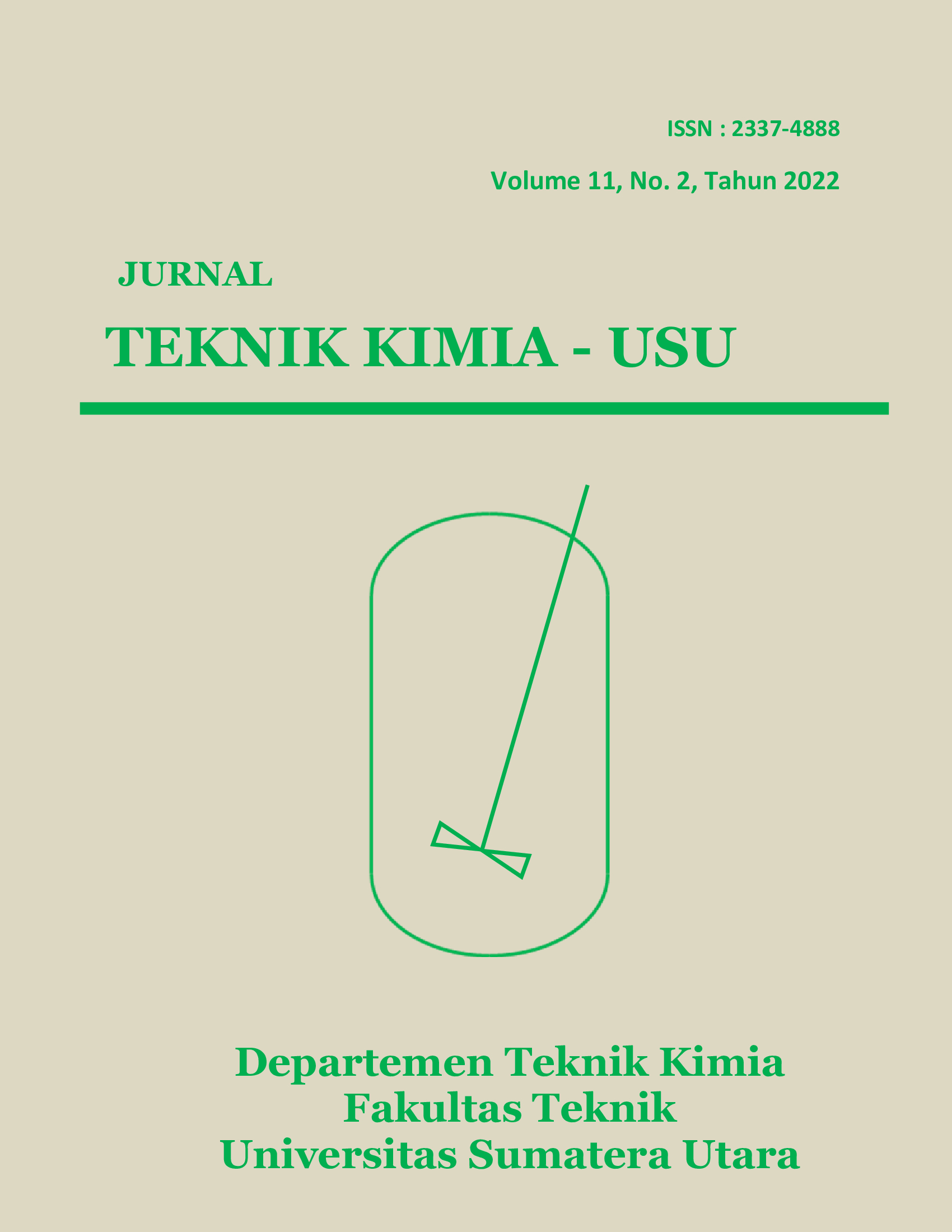Analisis Kuat Tarik dan Umur Perekat Poliamida Berbasis Gelatin dan Asam Adipat dengan Variasi Jumlah Minyak Sawit sebagai Pemlastis
DOI:
https://doi.org/10.32734/jtk.v11i2.9115Keywords:
bioadhesive, gelatin, adipic acid, palm oil, tensile strengthAbstract
The adhesive that is widely used today is the synthetic one, which is carcinogenic to humans. It is necessary to produce adhesives based on natural resources (bioadhesive) to reduce the use of synthetic adhesive. Gelatin is a compound that has amine groups, while adipic acid is an organic acid that has carboxylic groups in its chemical structure so they can be primary ingredients to make adhesive. The research objective is to reduce the use of synthetic adhesives with best quality of bioadhesive. The steps of making the adhesives included polymerization reaction and hydrolyzed palm oil addition. The polymerization reaction is carried out in batches at 90 ℃ and 1 atm with mole ratio palm oil to gelatin variety of 0; 0.04; 0.08; 0.17; 0.33; 0.5; and 1. The best result for tensile strength is the ratio of 0.33 mole ratio of palm oil to gelatin for 1 day, 3 days, 7 days, and 14 days of curing time, respectively 1575.71 kPa, 2197.30 kPa, 3387.31 kPa, dan 3708.23 kPa.
Downloads
References
A. Pizzi and K. L. Mittal, Handbook of Adhesive Technology, 2nd ed. New York: Marcel Dekker, Inc, 2017.
I. N. Eskani, R. Widiastuti, and N. N. Lathifa, “Karakterisasi perekat alami dari tumbuhan untuk industri kerajinan,†Semnar Nas. Teknol. hijau 2, 2017, pp. 1–7.
J. T. Kim and A. N. Netravali, “Performance of protein-based wood bioadhesives and development of small-scale test method for characterizing properties of adhesive-bonded wood specimens,†J. Adhes. Sci. Technol., vol. 27, no. 18–19, pp. 2083–2093, 2013.
S. Ebnesajjad and A. H. Landrock, Adhesives Technology Handbook, 3rd ed. London: William Andrew - Elsevier, 2015.
P. Falamarzpour, T. Behzad, and A. Zamani, “Preparation of nanocellulose reinforced chitosan films, cross-linked by adipic acid,†Int. J. Mol. Sci., vol. 18, no. 2, pp. 1–12, 2017.
Y. Basiron, Palm Oil, in F. Shahidi, Bailey’s Industrial Oil and Fat Products, New Jersey: John Wiley & Sons, Ltd, 2005.
Bitar, “Hidrolisis : Pengertian, Manfaat, Dan Macam-Macam Beserta Contohnya Lengkap,†https://www.gurupendidikan.co.id/hidrolisis/ (accessed Jan. 03, 2021).
A. N. Anozie and J. M. Dzobo, “Kinetics of the hydrolysis of palm oil and palm kernel oil,†Ind. Eng. Chem. Res., vol. 45, no. 5, pp. 1604–1612, 2006.
C. E. Carraher and R. B. Seymour, “Introduction to polymer science and technology,†in ACS Symposium Series, 1985, pp. 13–47.
Anonim, “Cure Time,†2015. https://www.corrosionpedia.com/definition/1884/cure-time (accessed Jan. 03, 2021).
M. Rohman, A. Saepuddin, and M. A. Fardana, “ST41 tensile strength analysis of spiral groove welding with three current variations,†J. Pendidik. Tek. Mesin Undiksha, vol. 8, no. 2, pp. 62–68, 2020.
A. Ghurri, Dasar-Dasar Mekanika Fluida. Denpasar: Universitas Udayana, 2014.
S. Ruhendi, D. N. Koroh, F. A. Syamani, H. Yanti, S. S. Nurhaida, and T. Sucipto, Analisis Perekatan Kayu. Bogor: Institut Pertanian Bogor, 2007.
P. Setyopratomo, “Produksi asam lemak dari minyak kelapa sawit dengan proses hidrolisis,†J. Tek. Kim., vol. 7, no. 1, pp. 26–31, 2012.
Welsiliana, “Dekomposisi hemiselulosa sekam padi Oryza sativa oleh jamur pelapuk kayu,†BIO-EDU J. Pendidik. Biol., vol. 5, no. 2, pp. 86–91, 2020.
Downloads
Published
Issue
Section
License
Copyright (c) 2022 Jurnal Teknik Kimia USU

This work is licensed under a Creative Commons Attribution-ShareAlike 4.0 International License.

















